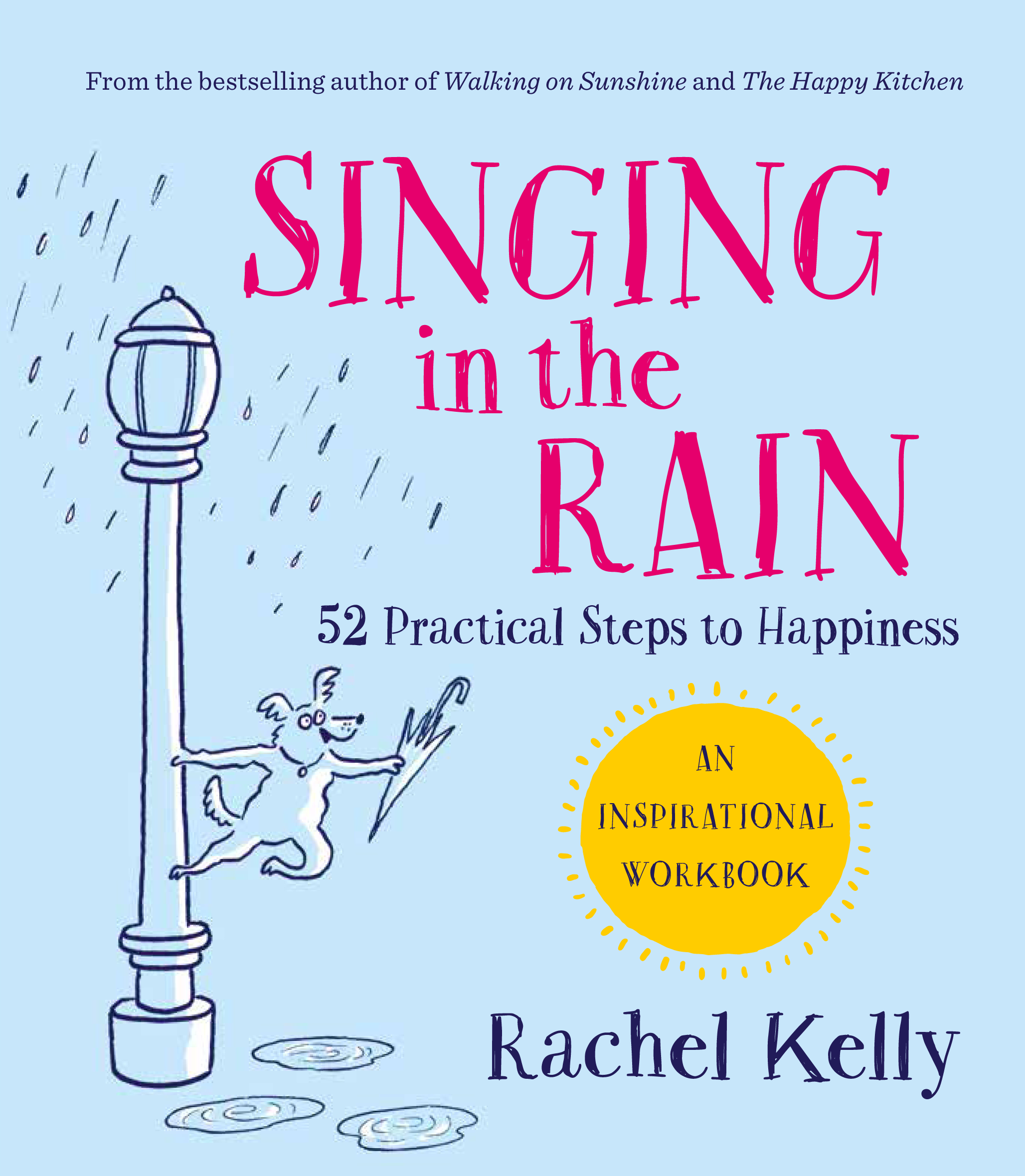Journalist Rachel Kelly author of new book Singing in the Rain: 52 Practical Steps to Happiness on how to be happy everyday
Unhappy days can seem as if they linger on forever. But little changes to your day can help. From making your bed to writing a letter, there are several little things you can add to everyday to make the dark days seem brighter.
#1 Make your bed in the morning with purpose
Refresh your sense of empowerment first thing by making your bed with care and focus. I make sure my white duvet is perfectly aligned and my pillows plumped. A small gesture to be sure, but one that reminds me that if I take control of small decisions in this way I will feel my own power to affect larger decisions.
Powerful businessmen and women and politicians often adopt these tactics to establish a sense of control when entering a boardroom or unfamiliar environment. They might change the position of a glass, or alter the height of the microphone on a pulpit, or reshuffle the papers in front of them. Follow their tactics to take back control over your own wellbeing and happiness and to feel a sense of agency.
#2 Identify all your different selves, and make time for them
We all embrace multiple selves, be it our work self, our family self or our sporting self (less developed in my own case). I know I enjoy life when I find time in my life for all of my different roles. Over-develop one side of our personality, and we can become unbalanced. It’s rather like a bird with an unduly strong right wing, which leaves it in danger of flying round and round in circles.
So while it’s generally healthy to feel integrated and whole, I have found it handy to imagine that I can also play different roles, each of which needs some time in the diary. This kind of compartmentalising is a skill mastered by many in order to maintain balance.
When I plan my diary, a happy day is now one where all my different roles get a look-in
Give yourself different names and symbols for your different aspects of my personality. For my self-parent role, I think of myself as Mum. The symbol for this might be me sitting at the end of a child’s bed chatting to them. At work, I am Rachel Kelly. This is the person who is grown up, or tries to be. The symbol would be me dressed in one of the crisp white shirts I favour when working.
With friends and when I’m socialising, I am Rach. This Rach is to be found at a corner table in a café, sharing something delicious and having a laugh with a pal. And then there’s just Rachel, who likes being on her own with her dog.
Being conscious of these roles has helped me fully inhabit my different identities, and potentially switch roles if that’s appropriate. Sometimes, when I am distressed, I try and figure out which aspect of me is dominant, and is that appropriate? There’s nothing worse than being in my professional work mode when a child needs some attention. When I plan my diary, a happy day is now one where all my different roles get a look-in.
#3 Learn this poem
We appreciate good times more by having experienced the bad. In fact, we would not appreciate sunnier times without living through the rainy ones. I love the way this idea is expressed in this poem by the 19th- century Scottish writer Charles Mackay. Learn it, and recite it every time life sucks.
Oh you tears,
I’m thankful that you run,
Though you trickle in the darkness,
You shall glitter in the sun
The rainbow could not shine if the rain
refused to fall,
And the eyes that cannot weep are the
saddest eyes of all.
#4 Adopt an appreciation pause
This is about appreciating those you wouldn’t routinely thank or notice in the busy rush to get things done. It could be the person at the till who serves you lunch, the office cleaner, the teacher who helped you solve a problem after class, a doctor who worked out why you haven’t been feeling well or the police officer patrolling your neighbourhood.
Take a moment to think of all these people in your life, people who admittedly are just doing their jobs, but as a result you may have overlooked them or taken them for granted.
Consider how our lives would fall apart without these individuals who look after our health, education, community and environment. Perhaps in the future you will make a point of thanking them. While adopting an appreciation pause is designed to consider those you don’t know well, it also works well for long-term partners and close friends and family members whom we often also overlook! Pause for a final moment to think about them too and quietly say thank you in your head.
#5 Write a handwritten letter
I have always enjoyed the rituals that surround letter writing, from the sealing of the envelope to the attaching of the stamp and the trip to a scarlet pillar-box. There’s also a great pleasure to be had in receiving a proper handwritten message as the post falls through the letterbox with an intriguing clunk.
It’s a chance to examine your emotional connection with someone in more depth
There are few nicer letters to write than ones that express gratitude to someone for the role they have played in our life. As I scribble away, I put aside my own worries and focus instead on what I’m thankful for. Anecdotal evidence collected about people in a nursing home found that one common regret among the dying is the wish that they had had the courage to express their feelings; a second is people wishing they had stayed in touch more with friends. Sending a letter saying why you care about someone combines both objectives.
Ideally, write by hand. This can feel odd in the digital age, but as we established at the start of this workbook, there is some-thing to be said for it. A handwritten letter can’t be rushed. It’s a chance to examine your emotional connection with someone in more depth.
#6 Get in touch with your vagus nerve
Edward Bullmore, professor of psychiatry at Cambridge University, believes that mental disorders may have their root cause in the immune system and looks at inflammation as a key factor. Stimulating our vagus nerve at the back of our throats may help reduce this unhelpful inflammation.
This nerve is so called because it wanders to so many different places in the body, like a vagabond. It begins in the brain stem, and then passes through the back of the throat before branching out when it reaches our digestive system and even stretches to a tiny part of the external ear canal. It acts automatically, increasing our heart rate and blood pressure when we are under stress and relaxing them when the threat passes.
The audible vibration we create and experience when chanting, gargling or humming can stimulate the vagus nerve. This could explain why chanting, and especially the ‘om’ sound are used in yoga and meditative practices. Get chanting.
#7 Imagine a pendulum
One way I have learnt to manage my stress levels has been to use mental imagery – to create or experience visual pictures in the mind. These images can help us understand and become aware of our moods, be they high or low, as well as control them. Cancer sufferers also use this method to help them relax and manage their symptoms.
By observing the pendulum, I watch my emotional volatility rather than ‘becoming’ it
First, the pendulum. This could be a stone, weight or crystal hanging from the end of a string. When I am calm, I imagine that the string is still, the book peacefully at the end of it, not moving to right or left. This is the happy middle ground, when I am in balance, neither too high nor too low. But when I get either overly stressed or overly excited, the pendulum starts to swing from side to side – a useful visual representation to remind me of my own mood swings.
Then at times when I feel really unstable, I imagine the pendulum swinging so fast it is out of control. This image reminds me I have little perspective, and can quickly become either upset and angry, or by contrast on too much of a high. The picture in my head is a reminder that I need to pause. I must find a way to calm down and return to the mid-point.
Using the pendulum image has helped me become more aware of my mood swings. I have learnt that it is better not to act when I feel so out of control, as I will almost certainly regret it. I also use this image as a way to disconnect from the feelings it represents. By observing the pendulum, I watch my emotional volatility rather than ‘becoming’ it.
Rachel Kelly is the bestselling author of Walking on Sunshine: 52 Small Steps to Happiness (2015), The Happy Kitchen: Good Mood Food (2016) and Black Rainbow: How words healed me: my journey through depression (Hodder & Stoughton, 2014).
Singing in the Rain is Rachel’s fourth book. Beginning her career as a journalist on The Times – after battling with depression in early adulthood – she became interested in health and therapy.
She is now an official ambassador for SANE, Rethink Mental Illness and The Counselling Foundation and lives in West London.
Singing in the Rain: An inspirational workbook on Amazon.
More Healthista content:
WIN an overnight spa stay worth £279
The rise of the veggan – why some vegans now eat eggs
Mental health fixes – 13 women share what makes them happy
6 reasons social media is making you unhappy (and what to do instead)
Like this article? Sign up to our newsletter to get more articles like this delivered straight to your inbox.



























































